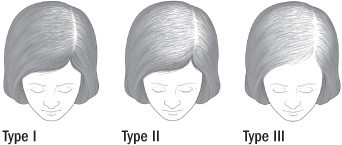
Nearly every women will develop some degree of thinning over their lifetime. Approximately one-third of women will experience noticeable hair loss (alopecia) during their life time. For most, it becomes noticeable after menopause affecting nearly two-thirds of postmenopausal women. While most men expect to experience some noticeable hair loss, most women do not and it can have a significant impact on them socially and their emotional well-being.
Most women suffer from androgenic alopecia. This is the same kind that affects men, but women are affected differently. Women experience thinning of the part line, followed by diffuse thinning over the top of the head. Unlike men, women rarely experience a receding hairline or go bald.
There are many possible causes for hair loss in women including: physical or emotional stress, medications, medical problems, and genetics. If one notices any unusual hair loss, it is important to see one’s Primary Care Provider or Dermatologist to ensure that there are no underlying causes. If one is undergoing emotional difficulties, seeking the help of a therapist or support group may be helpful.
Androgenic alopecia is a result of the action of normal male sexual hormones, called androgens. These hormones play essential roles in both men and women, including sex drive, sexual regulation, and hair growth. Rarely, a tumor may be the cause of excess hormones. In any case, hair loss results from a shortening of the growth (anagen) phase of the hair growth cycle. The amount of time that a hair grows (normally 2-5 years on the scalp) shortens more and more, causing a finer, thinner hair–a process called “follicular miniaturization”. The super fine hairs that result are called “vellus” hairs or “peach fuzz”, in Layman’s terms.
Treatment:
Minoxidil (Rogaine) was initially used for high blood pressure, but was found to regrow hair. It now comes in 2 strengths: 2% and 5%. In general, the application of 5% minoxidil ONCE daily can help for some women. Results take 2 months to appear and peak at around 4-6 months. For most, a trial of 6-12 months is needed. The product is safe and less then one-third will grow new hair while up to 88% will not lose more hair.
Anti-androgens: Testosterone and other “male” hormones can make hair loss worse in women. Those who take male hormones for other reasons should consider stopping. Those who fail topical minoxidil may wish to try an anti-androgen drug, such as spironolactone (Aldactone). This works very well in those with polycystic ovary syndrome (PCOS) who make excess androgens. A women taking this medication cannot and should not get pregnant as a male fetus will have permanent genital abnormalities. While this medication is generally well-tolerated, some will experience weight gain, fatigue, loss of libido, and depression.
Iron Supplements: While not common, iron deficiency can cause hair loss. Those with heavy menstrual periods and vegetarians are more at risk. One can have their iron level checked and, if low, supplements can be given.
Hair Transplantation: This procedure has been used since the 1950s and has been refined to produce a better result. Most surgeons today perform “follicular unit transplantation”, which was first used in the mid-1990s. Results are permanent, although future loss may occur unless one treats the underlying condition as described above.
PRP: Using platelets from one’s own blood has been used to simulate hair growth with some success. Results vary greatly from provider to provider and from one technique to the next, but some will experience up to a 25% improvement and sometimes more. You may read more about PRP HERE
LED Light Treatment: Many devices are now approved to treat androgenic alopecia, but they are all not the same. To date, there are no contradictions for this treatment and no known drug interactions between LED light treatment and other medications used for hair loss. Some believe that light treatment may complement other treatments, such as PRP. Red lights work well, but again devices differ greatly in both cost and results. Dual wavelength LED light therapy utilizes more than one wavelength (color) and has shown promising results. The Revian Red system has been clinically proven to help regrow hair and comes with a 6-month money back guarantee. Click here for more information about this device.
